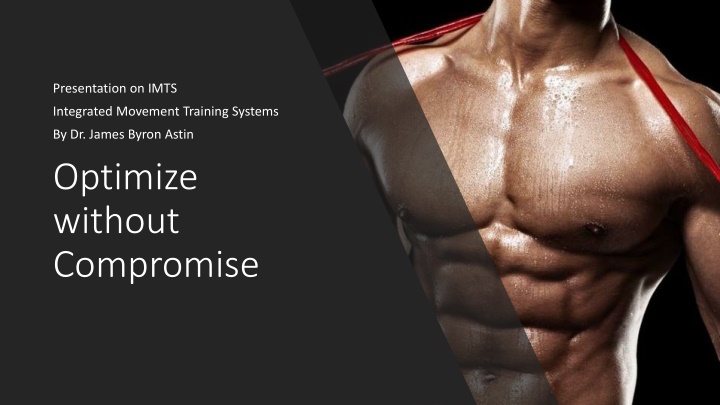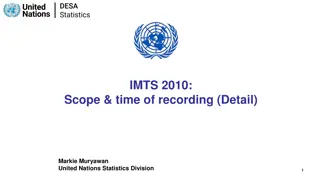
Optimize Training with IMTS Integrated Movement Systems
Explore the benefits of IMTS for total body conditioning and optimal performance. Learn about specific and general adaptation to training demands, as well as the critical role of Supercompensation and the SAID principle in achieving fitness goals without compromise.
Download Presentation

Please find below an Image/Link to download the presentation.
The content on the website is provided AS IS for your information and personal use only. It may not be sold, licensed, or shared on other websites without obtaining consent from the author. If you encounter any issues during the download, it is possible that the publisher has removed the file from their server.
You are allowed to download the files provided on this website for personal or commercial use, subject to the condition that they are used lawfully. All files are the property of their respective owners.
The content on the website is provided AS IS for your information and personal use only. It may not be sold, licensed, or shared on other websites without obtaining consent from the author.
E N D
Presentation Transcript
Presentation on IMTS Integrated Movement Training Systems By Dr. James Byron Astin Optimize without Compromise
IMTS: Making it REAL Optimize training for total body conditioning by incorporating into the physical fitness routine: multiplanar exercises, varied ranges of motion (ROM), angles of tissue stress, and joint mobilization techniques. Improve body control for expression Vary lines of stress for maximal adaptive capacity Muscle balance training for symmetry of force conduction Minimize injury, and reduce compensation and function loss
Benefit Learn Understand Strength and conditioning benefits from IMTS functional training. Learn how to use the S.A.I.D principle to get the results you want! Understand the role G.A.S has in an athlete s training cycle. Presentation Objectives
Specific Adaption to Imposed Demands Specific adaptations take place in the body in response to specific types of stimuli. What you train for is what you get S.A.I.D. The SAID principle is the key factor in determining the responses that will occur as a result of your training habits and programming, e.g.: Lift heavy, become strong Lift heavy with high volume, become big Overeat, also become big (with body fat) Do lots of cardio, get better at aerobic endurance Lift explosively, gain power
General Adaptation Syndrome Is the predictable way in which the body responds and adapts to stress. G.A.S. Four phases Phase 1: Alarm Reaction The body reacts to the stressors of training Phase 2: Resistance The body protects itself from the stress of training Phase 3: Supercompensation occurs The body adapts to the training stress, S.A.I.D. Stage 4: Exhaustion The body loses its ability to adapt to training
G.A.S. Supercompensation Phase 3 of G.A.S. The training period during which the trained function/parameter has a higher performance capacity than it did prior to the training period. When to change routine This varies from athlete to athlete and with good coaching and performance tracking the athlete should be easily able to figure out when the optimal timing is for novel stress induction. Average timing is around 18-21 days after Alarm Reaction This timing has a great deal of variation depending on: Health Rest and recovery cycles Diet Life stressors, such as job, family, bills, etc..
G.A.S. and S.A.I.D. Gain in one Used together can keep the athlete progressing area may be loss in another Ignored, can be the reason for lack of significant gains, plateaus and loss. Include functional variation, blending the two significant principles into a well balanced training program!
Integrated Movement Training Systems or functional training can have a significant impact on the long term gains of any athlete. IMTS for any Athlete For total body fitness and conditioning, it is the easiest to incorporate into any training routine.
What is IMTS? IMTS: Integrated Movement Training Systems The IMT process can be thought of as a systematic sequential reactivation of established, albeit obfuscated, primitive motor patterns by working from the earliest patterns (e.g. C-1 and C-2 mobilization).This particular process begins by articulating and mobilizing the cervical vertebral column first and utilizes the client s internal sensory feedback mechanisms as well as the movement coach s external observation. www.IMAS-training.systems Integrated Movement Training (IMT), is a system of training derived from the highest level of martial arts, developed and evolved over more than 7,000 years of movement inquiry. IMT can be undertaken within or without the context of martial arts
What is IMTS? IMTS: Integrated Movement Training Systems The IMT System of training applies reliable and timelessly consistent principles of Physics, Biology and Psychology of both the Ancient Warrior Shaman/Priest and complete modern Eastern and Western systems of conditioning regimens. As a comprehensive system of inclusionary practices no stone is left unturned in the process of self-mastery. The ultimate aim of the training is to establish a consistent, self- similar, reproducible process of sequential improvements to the whole person in line with their deepest most intrinsic motivation to be the best self they can be or imagine. As a result: The Warrior Athlete becomes comprehensively fit and fully FUNCTIONAL in Body, Mind And Spirit!
Why Functional Strength Matters According to the American Council on Exercise The primary goal of functional training is to transfer the improvements in strength achieved in one movement to enhancing the performance of another movement by affecting the entire neuromuscular system. The brain, which controls muscular movement, thinks in terms of whole motions, not individual muscles. Exercises that isolate joints and muscles are training muscles, not movements, which results in less functional improvement. https://www.acefitness.org/acefit/healthy-living-article/60/1452/what-is-functional-strength- training/
Every 18 to 21 days(give or take) IMTS: Make a simple but significant change to the workout routine. Training Process Change the angle of stress Change the load and rep parameters Alter the sequence of loading Combine/ stack muscle groups Alter R.O.M. Vary rep speed/tempo
Varying the routine. IMTS: Changing the angle of stress Muscular adaptation will occur along line of stress Changing the angles will help muscle bellies get bigger, fuller potentially improve symmetry Reduces Pattern overload, thus unwanted joint pain, and wear and tear on cartilage Examples for Chest: Flat bench, incline, decline, off-set loading, low abdomen touch vs. sternal, DB fly, DB press bilateral, DB press alternating, DB press reciprocating, DB Press isolateral, Push-ups varied hand position and body position Training Process
Varying the routine. IMTS: Change the load and rep parameters Heavy one cycle with low reps Light one cycle with high reps Heavy and light one cycle combined rep ranges Moderate load with high sets Moderate load with low rest Increase number of exercises Full body vs. Muscle segregation Training Process
Varying the routine. IMTS: Alter the sequence of loading and Combine/ stack muscle groups each cycle Load large to small muscles per session e.g. Back squat Front squat Leg extension Pre-loading small before large Keep load under control for safety This increases stress/alarm reaction on smaller muscles Training Process
Varying the routine. IMTS: Alter R.O.M. Full Range of Motion: The full movement potential of any joint, usually refers to the range of flexion and extension but include rotation, adduction and abduction. Correctly used, it will include all possible actions of each given joint. Training Process
Varying the routine. IMTS: Alter R.O.M. By exercising various ranges of motion the joints and the body s tissues will come to a better all around balance, aesthetic symmetry, and healthier function both in the short term and long term. It is Win/Win! Training Process
Including Functional Movement Enhancing the routine Training R.O.M. Shoulder Abduction Examples: A stacked triple set Flat bench heavy chest press 6-8 rep max Flat bench light DB chest fly, Full controlled ROM 12-20 rep max Exercise band moderate, seated horizontal abduction 12-20 reps, sub max
Including Functional Movement Enhancing the routine. Training R.O.M. Knee Joint Examples: A stacked triple set Front squat moderate 8-10 reps Machine leg extension heavy sub max 10-12 reps max Kneeling to knee stand, light KB or unloaded 12-20 reps, sub max
Functional Strength Matters Because Movement Matters 8 Primary Patterns from IMTS (Integrated Movement Training Systems) 1. Push 2. Pull 3. Lunge 4. Squat 5. Rotate 6. Crawl 7. Climb 8. Gait Secondary Sub-Patterns 1. Hinge 2. Lift 3. Carry 4. Jump 5. Vault 6. Swing 7. throw Train movement patterns independently or combine them together MOVE WELL. LIVE WELL.
Presentation based on IMTS Integrated Movement Training Systems Created by Dr. James Byron Astin Former Military Intelligence Analyst for the NSA Former Director of the Exercise Science program for BU Founder of the Institute of Movement Arts and Sciences Judge for the World Natural Bodybuilding Federation Director of Health and Wellness for W A R R IO R Senior Instructor of Wuji Quan-fa: a comprehensive Martial Art Wilderness Survival Guide and IMTS Coach W A R R IO R F IT F IT For more information and coaching: Email: the.wuji.warrior@gmail.com









